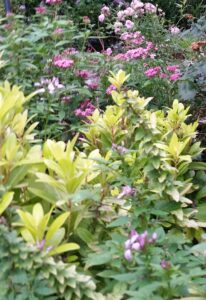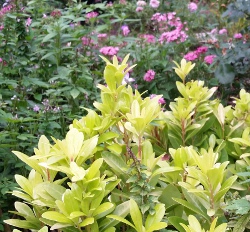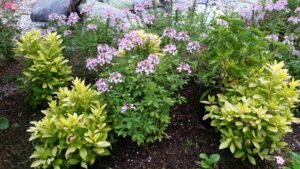S & J Tree Farm and Nursery’s
Anise ‘Florida Sunshine’
( Illicum parviflorum ‘Florida Sunshine’)
 ‘Florida Sunshine’ Anise Origins:
‘Florida Sunshine’ Anise Origins:
– A true Floridian plant! A seedling selection of the Florida native Illicum parviflorum / yellow anise plants from Florida plantsman Charles Web. These bright golden plants were an instant favorite for me and have performed well in my sandy soil landscape for the past few years.
– Not always readily available Florida Sunshine Anise can be harder to find as
they are still relatively a new introduction to the plant trade. For me, they are well worth the effort it takes to track them down or a little patience to wait for the next crop to be ready.
Anise ‘Florida Sunshine’ Preferred Exposure:
– Anise parviflorum will tolerate full sun to full shade situations in the
North Florida | Jacksonville | St. Augustine areas gardens.
– In my home garden they receive sun all day until about three to four o’clock in the afternoon when they are shaded by an old Oak tree about 30 feet from where they are planted into the garden as the sun is in the west for the rest of the evening.
Anise parviflorum ‘Florida Sunshine’ Foliage:
– Large light chartreuse green colored foliage has a thick almost leathery feel to the leaves and turns a bright yellow with the new leaf flushes in spring and again in the fall. During the winter in colder climates the foliage tips may turn a pale yellow almost creamy white.
– Evergreen foliage has a strong licorice scent when crushed or cut.
Yellow Florida ‘Sunshine Anise’ Soil Preference / Salt tolerance:
– Illicum parviflorum is remarkable adaptive to a wide range of soil
components and moisture levels, from wet to dry and sandy to clay.
– Illicum parviflorum has a low salt tolerance and should be avoided on
coastal properties.
Size and Growth Habit of ‘Florida Sunshine’  Anise:
Anise:
– A more compact selection of Illicum parviflorum that can grow 5-8 ft
High and 3-4 ft wide and has been easily maintained for me in my home gardens at 2-3 feet with annual pruning.
– Moderate to fast growth rate at 6-8 inches per year and responds well to pruning, quickly branching out and filling in after trimmings.
Yellow Florida Anise Water Requirements:
– Yellow Florida Anise is moderately drought tolerant once established into the landscape but native to the wetter areas of Florida.
– In my home garden, the Florida Sunshine Anise is planted into extremely
sandy soil that was amended with compost at the time of planting. I have no Irrigation system in that area and find that they do best when I water them once a week. During a dry spell I sometimes twice a week in the hear of summer when there has been no rain. To me they are easy to maintain and
forgiving of my negligence when I forget to give them some water.
Care of S & J Nursery’s North Florida |  Jacksonville | St. Augustine Shrubs:
Jacksonville | St. Augustine Shrubs:
– Shrubs can be planted in the North Florida | Jacksonville | St. Augustine area at any time during the year. In normal and well draining soils dig the hole as deep as the root ball and two to three times as wide. Plant the top of the root ball level or slightly higher than the surrounding soils. When planting in poorly drained soils make sure to plant your shrubs a minimum of 3 inches ABOVE the surrounding soil level.
– Water every day during the establishment period. For most 3 gallon size shrubs in the North Florida landscape in average soil, that is neither heavy clay that holds water or really sandy that will take 2-3 weeks of daily watering to ensure that your newly planted shrub will begin to put out new roots and grow into its new home happily. After the first few weeks begin tapering back your watering to every other day then every third day and so on until your newly planted items are flourishing without your assistance.
– If planting larger shrubs you may need to extend the initial care a bit longer to protect your investment and get your shrubs off to the best start possible.
– IMPORTANT: If planting shrubs in heavy clay soils that hold allot of water after a rain or irrigating, remember to check the soil for moisture by sticking your fingers into the soil near the root ball of the newly planted shrub down to 2-3 inches. If it remains wet from the previous watering wait for the top 2-3 inches to dry out before watering again.
– IMPORTANT: When planting shrubs into poor sandy soils be sure to amend the planting hole by mixing compost or cow manure etc. with the native soil that will go back in the hole around the new plants root ball when installing your shrub material, this will not only give your new shrubs good soil to grow its new roots into but help it hold water.
– When planting shrubs from containers be sure to loosen the roots as much as possible pulling loose roots away from the root ball before installing your new plants, if the roots are to tight to easily loosen with your hands use a knife to cut a few slits into the root ball being careful to go all the way from the top to the bottom and making the cut at least an inch deep. This will ensure that your plant will immediately begin to form new roots into its new surrounding soil.
– Mulch newly planted shrubs whenever possible.
– Fertilize each spring with a mixture of Milorganite and a slow release poly coated plant food such as Osmocote or Stay Green general purpose plant food, sprinkling the fertilizer around the mulch circle underneath the foliage of the tree
– Prune as needed to shape each spring and or summer as you see fit.

